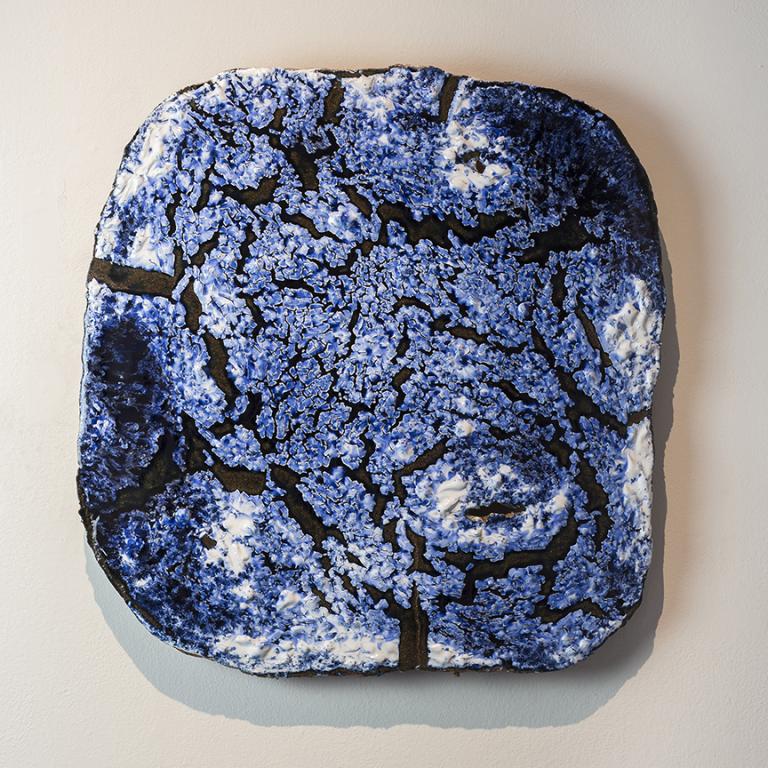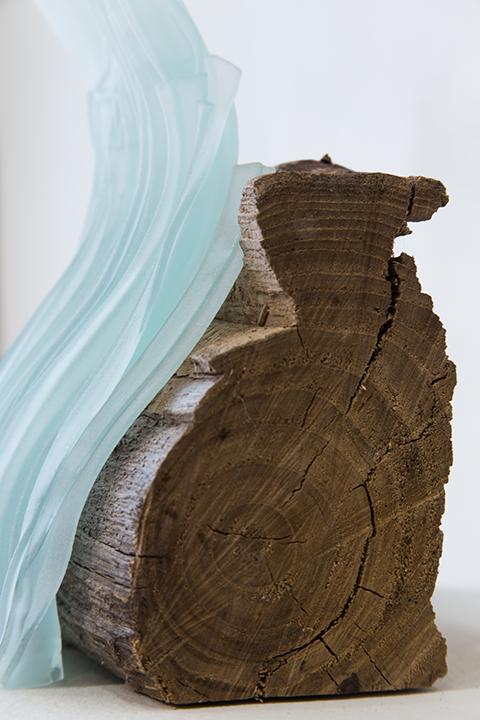
MFA Thesis Exhibitions run April 3-21
calendar icon29 Mar 2017

Lincoln, Neb.—Eight graduating Master of Fine Arts students from the University of Nebraska–Lincoln’s School of Art, Art History & Design will present their MFA Thesis Exhibitions in three exhibitions on display between April 3-21 in the Eisentrager-Howard Gallery in Richards Hall.
The first MFA Thesis Exhibition runs April 3-7 and features the work of Larry Buller, Rana Young and Michael Villarreal. A reception will be held April 7 from 5-7 p.m.
The second MFA Thesis Exhibition runs April 10-14 and features the work of Louise Deroualle, Bryon Hartley and Stuart Gair. A reception will be held April 14 from 5-7 p.m.
The third MFA Thesis Exhibition runs April 17-21 and features the work of Emily Reason and Stephanie Wright. A reception will be held April 21 from 5-7 p.m.
Larry Buller
Buller’s exhibition is titled “Domestic Curiosities.” Buller creates ceramic objects that explore issues of sexual identity, the phallus and fetish objects. These highly ornamental and kitschy works masquerade as items that one might typically find in a domestic setting. However, upon closer inspection, the viewer will discover a more subversive intention. In 2016, Buller’s work was exhibited as part of the national juried student show at the National Council on Education for the Ceramic Arts (NCECA) annual convention in Kansas City. He has also shown work at Doane College in Crete, Metropolitan Community College in Omaha and Tugboat Gallery in Lincoln. A native of Nebraska, Buller earned his Bachelor of Fine Arts and Masters in Education from the University of Nebraska–Lincoln. He taught ceramics at the high school level before pursuing his MFA. In his artist statement, he writes, “I create art that subverts the connection between function and non-function, vulgar and tasteful and chaste and sinister. I invite the viewer to enjoy the dichotomy of this line of inquiry while questioning previously held beliefs concerning the role of ceramic art as a change agent in society.”
Rana Young
Young’s exhibition is titled “The Rug’s Topography.” Through photography she investigates foundations of gender expression. Raised in the Midwest, she witnessed predominantly gender-normative roles, a construct ultimately defined by anatomy. She is interested in how normative values shape maturation and impact an individual’s gender performance and perception in adulthood. The photographs in The Rug’s Topography employ themes of tension, voyeurism and transition, to represent interpretation of the self. Young writes in her artist statement, “My work contributes to a current cultural dialogue that challenges preconceived notions regarding traditional gender ideals both self-imposed and societally prescribed. I construct images that balance between organic intimacy and cinematic theatricality by implementing symbolism, color theory, and seductive lighting to evoke tension. Utilizing a directorial approach and a single subject allowed me to create an environment that transforms viewer into voyeur.” An Othmer Fellowship recipient, Young serves as an Installation Photographer for the Sheldon Museum of Art. She received her BFA in studio art from Portland State University. Recently, she was included in Detroit Center for Photography’s “NEW DIRECTIONS Gallery,” awarded Second Place in the “2016 Lenscratch Student Prize” and was a recipient of Society for Photographic Education’s “2016 Innovations in Imaging Award.”
Michael Villarreal
Villarreal’s exhibition is titled “Whitetail.” In his artist statement, he writes, “I am a third-generation citizen aware of both a past family culture and an inherited one. Growing up, both my parents worked at a U-Haul where they brought home discarded objects on a weekly basis, to a house my dad built with his own hands. Our home was a repository of their taste and a home for abandoned domestic American culture. Beds, window blinds, couches and other products made it into the home which made it possible to function and have a normal lifestyle. The way I approach my work is never from any directly observed source. Similar to my childhood, anything I want to convey is completed from memory. I take materials that are common for the construction of houses such as pink insulation foam, joint compound, paint, and configure these materials on a wooden structure to give the work material integrity. By doing this, each work plays on metaphor and becomes relatively domestic.” Villarreal was born in Austin, Texas, and raised in Lockhart, Texas. He received his BFA from Texas State University with an emphasis in painting. He has exhibited his work nationally at multiple commercial art galleries. He was recently awarded the Mayor’s Arts Award in Lincoln, which includes a residency at the Kimmel Harding Nelson Center in Nebraska City and a stipend. In the coming months, he is participating in a group exhibition at Nebraska Wesleyan and Tugboat Gallery in Lincoln and will have a solo exhibition in Lockhart, Texas, at Spellerberg Projects.
Louise Deroualle
Deroualle’s exhibition is titled “Substrato para devaneios.” She is interested in creating objects that can reach individuals in an emotional way through their formal qualities. She writes in her artist statement, “The content of my work comes from personal experiences and encounters with the natural landscape around me. Contemplating my surroundings allows me to have a quiet and introspective moment of interaction with myself, making it possible for me to get in touch with my own subjectivity and understanding the way I perceive and experience the world.” After receiving her BFA from the Fundação Armando Alvares Penteado in Sao Paolo, Brazil, in 2001, Deroualle became an apprentice to Brazilian ceramic artist Lucia Ramenzoni with whom she worked for the next seven years. In 2009 she opened her own ceramic studio in which she taught ceramics classes and designed and produced a line of handmade functional pottery. Since 2010 she has been involved with both the Curaumilla Art Center in Chile, and the Anderson Ranch Arts Center in Aspen, Colorado, as a studio and teaching assistant.
Stuart Gair
Gair’s exhibition is titled “Object Landscape.” The functional vessels he makes are for use and display. Gair writes in his artist statement, “It is of the upmost importance that each piece has a duality of utilitarian purpose and serves as an object of beauty and intrigue when not in use. Formal considerations are a result of an in-depth exploration of historical objects from Japan, China, and Korea as well as mid twentieth century Scandinavian, American, and British forms. I draw comparisons from these pieces to one another and to everyday objects that surround me.” Gair received a history degree from Ohio University. Recently, he completed a residency program at Watershed Art Center as the Salad Days artist, which required him to make more than 500 plates for an annual fundraiser held in Newcastle, Maine. Gair examines a wide range of wares that have endured through time with a particular interest in how form follows function, silhouette and volume. All of the pieces that he creates are fired to cone 8 in a soda kiln. His background in the study of history provides him with insight about his own work in reference to a larger historical context. This summer, Gair will attend the Archie Bray Foundation in Helena, Montana, as a Resident Artist.
Bryon Hartley
Hartley’s exhibition is titled “Pause.” He is a sculptor who works with glass, wood and metal. He writes in his artist statement, “Creating Art honors the traditions of making by hand and presents an arena where I am the designer and the maker. When I make, I hunt myself down; I pursue that moment when a piece is finished and I can pause. The making process totally consumes me, hours are spent planning, sketching, fabricating, jig building and mold making. I reach the point of exhaustion trying to figure out positive and negative space, perfecting a line, curve, or form. Sleep is longed for, but I drive on. I am chasing perfection and once it is reached, I am a peace. It is a euphoric high.” Hartley grew up in central Illinois and currently maintains a residence and studio in Dawson, Illinois. He earned his BFA from Southern Illinois University at Edwardsville. He has presented his work in countless group exhibitions and has several public art pieces on display across the country.
Emily Reason
Reason’s exhibition is titled “Ephemeral Permanence.” Reason sees beauty as inextricably linked to nature and spirituality. In her artist statement, she writes, “I present my symbolic vocabulary, which when defined by the viewer is colored by their own experiences. For me, object-making is a necessary means to make permanent what is ephemeral. . . . . Wildlife plays the role of itself—elusive, mysterious and majestic, as well as metaphor for human character and spirituality. Barns, silos, sheds, jars, jugs and bowls carry the mark of the man-made world. I insert into my narrative works complex dynamics of domestic and wild, beauty and destruction, order and chaos.” Reason is a Graduate Fellow with the Center for Great Plains Studies. She grew up in Pittsburgh, Pennsylvania, and received her BFA from West Virginia University. Between her degrees, she completed two artist residencies, taught workshops, co-founded a gallery of fine craft in North Carolina, authored an instructional book on wheel-throwing pottery and operated her private ceramics studio. Reason uses clay to memorialize culture and poignant personal experiences.
Stephanie Wright
Wright’s exhibition title will be announced at the exhibit. The subjects of her prints are in performance for a human audience. She writes in her artist statement, “These animals address broader human experience; certainly the notions of ‘human nature’ and culture are themselves human constructs. Our ability to empathize with animals is tied to the perceptions that human society creates for them through fables, myths, religion, everyday interaction and animal husbandry. Our reaction to recognizable animal figures is affected by the meaning that we apply to them. We self-consciously work to define our existence through them. The animals in my work perform, unhappily for the viewer. Like hand puppets, they are stand-ins that allow me to talk about living through fear, social anxiety and disenchantment. I’m uncomfortable and dissatisfied. I’m afraid to have kids. I’m afraid to be the boss. I’m afraid to be a teacher and I’m afraid to be a lover. I’m afraid to compete. I’m afraid to play the game. But I’m afraid to be alone.” Wright grew up in Louisiana and earned her BFA at the University of Louisiana at Lafayette.
Gallery hours for the MFA Thesis Exhibitions are Monday-Friday, 12:30-4:30 p.m. Admission to the gallery is free and open to the public.
The Eisentrager-Howard Gallery is located on the first floor of Richards Hall at Stadium Drive and T sts on the UNL city campus. For more information, contact the School of Art, Art History & Design at (402) 472-5522.